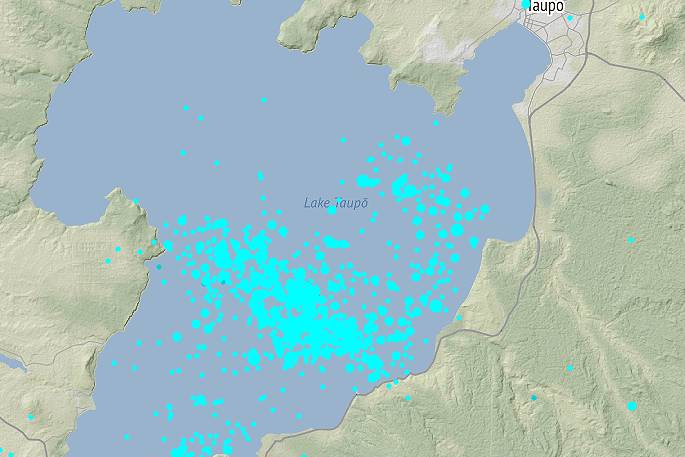You could be forgiven for thinking that Taupō is just a large lake to the north of the Tongariro National Park volcanoes.
Hidden beneath the lake is Taupō volcano, which started life about 200,000 years ago.
In the last 30,000 years two caldera-forming eruptions, both holding their own in global volcanology, have occurred at Taupō, says a GeoNet spokesperson.
About Taupō volcano
The name Taupō, comes from 'Taupō-nui-a–Tia,” meaning the 'the great cloak of Tia.” In Māori history, the early explorer and chief Tia noticed the peculiar colouring and appearance of a cliff face along the shores of Lake Taupō that resembled the cloak he was wearing, later resulting in the name for the area.
Twenty-nine eruptions have occurred from Taupō volcano in the last 30,000 years, the most recent just 1800 years ago.
"We know that Taupō is still active because it shows signs of what we call ‘volcanic unrest': small earthquakes, movement of the ground up and down, and changes in the geothermal fields in the area," says GeoNet.
"There have been at least 17 episodes of volcanic unrest at Taupō in the last 140 years."
What the new research discovered
The ECLIPSE (Eruption or Catastrophe: Learning to Implement Preparedness for future Supervolcano Eruptions) project is made up of a multi-institutional team run through Te Herenga Waka—Victoria University of Wellington, in collaboration with GNS Science and Massey University.
It includes several GNS Science volcano experts, with an aim to understand volcanic unrest at New Zealand's largest volcanoes.
The ECLIPSE research has recently interpreted a series of earthquake swarms in Taupō during 2019 as a period of volcanic unrest.
"The research, conducted after the unrest period, used the publicly available earthquake and GNSS data from GeoNet's monitoring network to investigate this distinct period of heightened seismic activity and ground deformation," saus GeoNet.
 More 1100 shallow earthquakes (under 40km deep) located in and around Taupō during 2019.
More 1100 shallow earthquakes (under 40km deep) located in and around Taupō during 2019.
The research has also provided insights to the area of hot mushy rock under Taupō, estimated to have a volume of at least 250 km3, more than 50km3 of which is molten.
The research indicates new magma was being fed into this reservoir and this caused the triggering of earthquakes in the surrounding brittle crust along fault lines that reflect both the volcano structure and the regional rift faults that cut across the volcano.
Taupō volcano's explosive history
Taupō volcano is one of eight caldera volcanoes in the central portion of the Taupō Volcanic Zone (Te Ahi Tupua).
"Two of these have been active in the last 30,000 years, Okataina and Taupō. Taupō is known globally for its two caldera-forming eruptions in this time," says GeoNet.
"The Oruanui eruption - which produced one of, if not the largest eruption in the world in the last 26,000 years – covered the central North Island in at least 530 cubic kilometres of superhot gassy magma, much of which was laid down as an unwelded ignimbrite.
"The hole under the ground that was left after all this magma was emitted, collapsed forming the Oruanui caldera. Later this depression filled with water to form a new lake."
he most recent eruption was the Taupō pumice eruption about 1800 years ago, when about 35 cubic kilometres were deposited in the central North Island as valley-fill ignimbrite and air-fall pumice.
Another caldera was formed deepening the northeast part of Lake Taupō. What may have been the effects of this eruption were recorded in China and Italy as unusual sunsets.
Between these two large eruptions there were at least 26 much smaller eruptions which formed lava domes or spread pumice and ash over nearby areas.
Some were only the same size as the Ruapehu 1995-96 eruptions. Since 1872 there have been 17 episodes of unrest at Taupō volcano.
Will Taupō volcano erupt again?
Geologically speaking, Taupō volcano is a very active volcano and further periods of volcanic unrest are likely to lead to an eruption at some stage, although this could be hundreds of years away, says GeoNet.
The volcano is carefully monitored by GNS Science through the GeoNet program using seismic, ground deformation and chemistry techniques.
"In New Zealand, we use a system of Volcanic Alert Levels to define the current status of each volcano. Taupō volcano currently is currently at Volcanic Alert Level 0 – no volcanic unrest.
"An eruption may occur at any level, and levels may not move in sequence as activity can change rapidly.
"The extensive GeoNet data combined with research projects like ECLIPSE will help better understand the active volcanoes in New Zealand such as Taupō, and the challenge of interpreting and explaining the implications of volcanic unrest.
"Data collected by GeoNet is freely available to support research on geological hazards in New Zealand."
Click for more information on:
The new research - Volcanic Unrest at Taupō volcano in 2019: Causes, Mechanisms and Implications



0 comments
Leave a Comment
You must be logged in to make a comment.